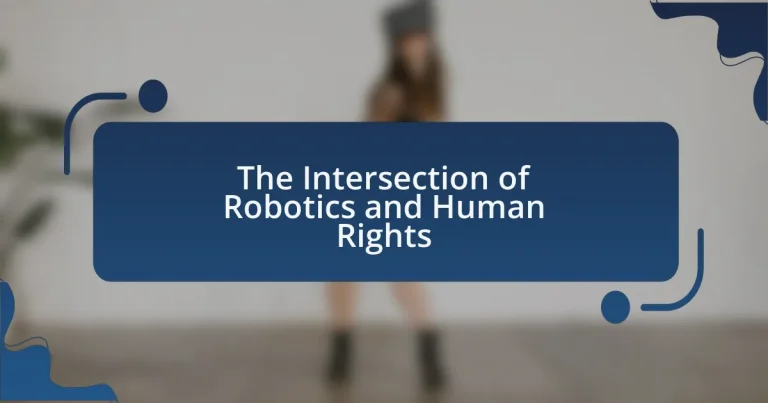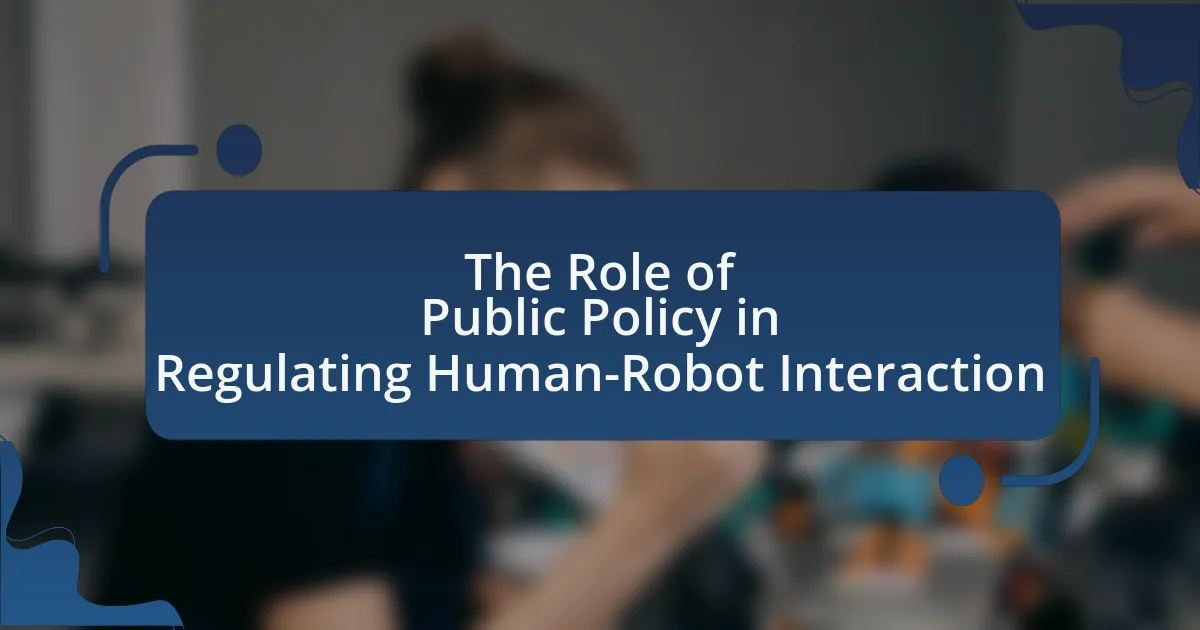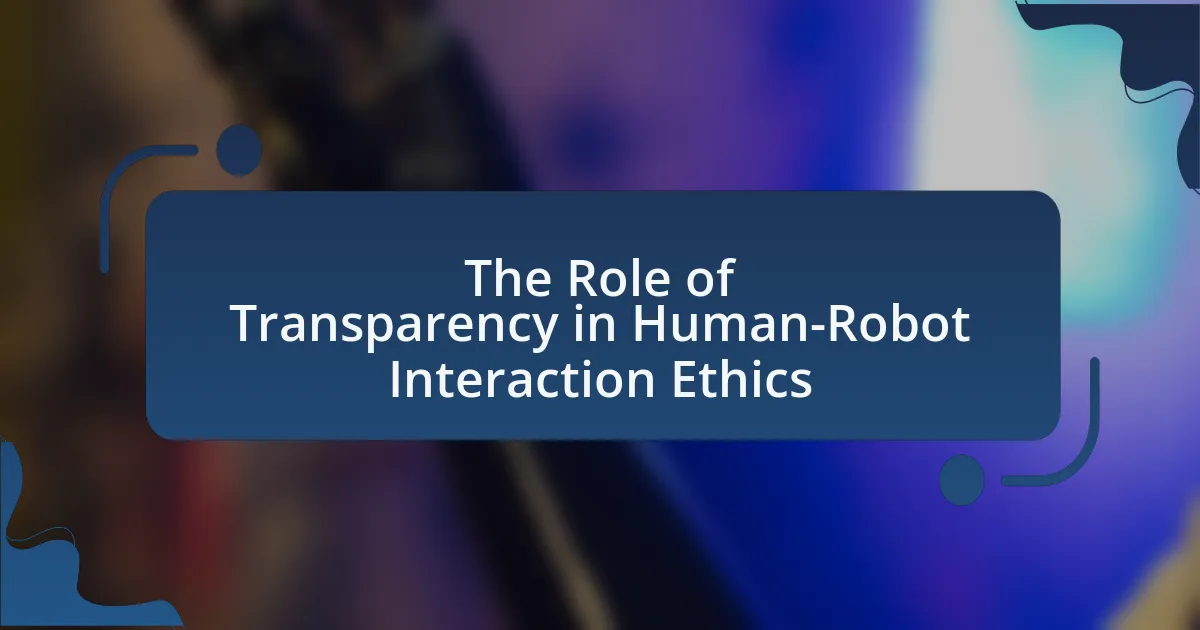The article examines the intersection of robotics and human rights, focusing on the ethical implications and potential impacts of robotic technologies on individual rights and freedoms. It highlights concerns related to privacy, autonomy, accountability, and discrimination as robotics becomes integrated into sectors such as healthcare, law enforcement, and military applications. Key concepts discussed include the need for regulatory frameworks to protect human rights, the role of ethical guidelines in robotics development, and the implications of automation on labor rights. The article emphasizes the importance of public awareness and policymaker involvement in ensuring that robotic advancements align with human rights standards.
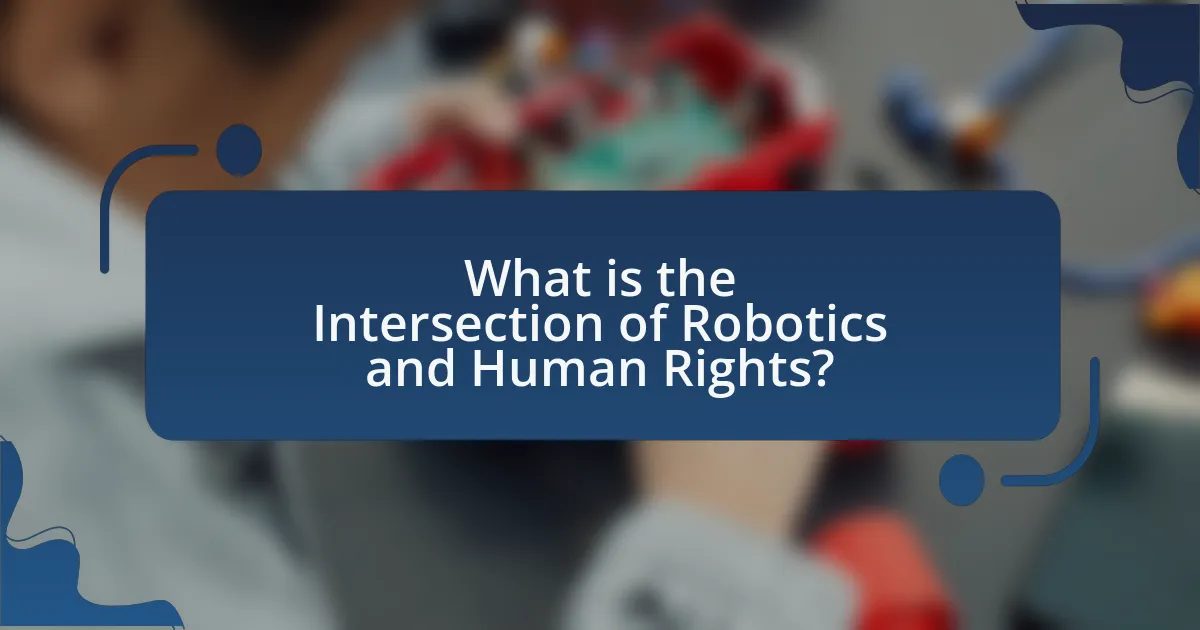
What is the Intersection of Robotics and Human Rights?
The intersection of robotics and human rights involves the ethical implications and potential impacts of robotic technologies on individual rights and freedoms. As robotics increasingly integrates into various sectors, including healthcare, law enforcement, and military applications, concerns arise regarding privacy, autonomy, and accountability. For instance, the deployment of surveillance drones raises questions about the right to privacy, while autonomous weapons systems challenge the principles of accountability in warfare. Reports from organizations like Human Rights Watch highlight the need for regulatory frameworks to ensure that robotic technologies do not infringe upon fundamental human rights, emphasizing the importance of ethical guidelines in their development and use.
How do robotics and human rights relate to each other?
Robotics and human rights are interconnected through the ethical implications of robotic technologies on individual freedoms and dignity. As robotics increasingly permeates various sectors, including healthcare, law enforcement, and labor, it raises concerns about privacy, autonomy, and the potential for discrimination. For instance, the deployment of surveillance robots can infringe on the right to privacy, while autonomous weapons systems pose risks to the right to life and the principles of proportionality in conflict. The United Nations has recognized these issues, emphasizing the need for regulations that ensure robotics development aligns with human rights standards, as outlined in documents like the Universal Declaration of Human Rights.
What are the key concepts in robotics that impact human rights?
Key concepts in robotics that impact human rights include autonomy, surveillance, accountability, and bias. Autonomy in robotics raises concerns about decision-making processes that may affect individuals’ rights, particularly in military and law enforcement applications. Surveillance technologies, such as drones and facial recognition systems, can infringe on privacy rights and lead to disproportionate monitoring of certain communities. Accountability is crucial, as the deployment of robots in sensitive areas necessitates clear responsibility for actions taken by these machines, especially in cases of harm or violation of rights. Lastly, bias in algorithms can perpetuate discrimination, impacting marginalized groups and undermining equality. These concepts highlight the need for ethical frameworks and regulations to safeguard human rights in the evolving landscape of robotics.
How do human rights frameworks apply to robotics?
Human rights frameworks apply to robotics by establishing ethical guidelines and legal standards that govern the development and deployment of robotic technologies. These frameworks ensure that robotics respect fundamental human rights, such as privacy, dignity, and non-discrimination. For instance, the Universal Declaration of Human Rights emphasizes the right to privacy, which is relevant in the context of surveillance robots and data collection. Additionally, the European Union’s General Data Protection Regulation (GDPR) sets strict rules on data handling, impacting how robots process personal information. These legal instruments highlight the necessity for robotic systems to be designed and operated in ways that uphold human rights, thereby fostering accountability and protecting individuals from potential abuses associated with robotic technologies.
Why is the intersection of robotics and human rights important?
The intersection of robotics and human rights is important because it addresses the ethical implications and potential impacts of robotic technologies on individual freedoms and societal norms. As robotics increasingly integrates into various sectors, including healthcare, law enforcement, and military applications, it raises critical concerns about privacy, autonomy, and discrimination. For instance, the deployment of autonomous drones in warfare can lead to violations of international humanitarian law, while the use of surveillance robots can infringe on citizens’ rights to privacy. These scenarios highlight the necessity for frameworks that ensure robotic advancements do not compromise human rights, as evidenced by reports from organizations like Human Rights Watch, which emphasize the need for regulations that protect individuals from potential abuses stemming from robotic technologies.
What potential risks do robotics pose to human rights?
Robotics pose several potential risks to human rights, primarily through issues of surveillance, autonomy, and employment. The deployment of robotic systems in surveillance can infringe on privacy rights, as seen in the use of drones and facial recognition technology, which can monitor individuals without consent. Additionally, the automation of jobs through robotics threatens economic rights by displacing workers, leading to increased unemployment and economic inequality. Furthermore, the use of autonomous weapons raises ethical concerns regarding accountability and the right to life, as decisions about lethal force may be made by machines rather than humans. These risks highlight the need for regulatory frameworks to protect human rights in the context of advancing robotic technologies.
How can robotics enhance the protection of human rights?
Robotics can enhance the protection of human rights by providing tools for monitoring, reporting, and responding to human rights violations. For instance, drones equipped with cameras can document abuses in conflict zones, allowing for real-time evidence collection that can be used in legal proceedings. Additionally, robotic systems can assist in delivering humanitarian aid to inaccessible areas, ensuring that vulnerable populations receive necessary support. Research by the United Nations has shown that technology, including robotics, can improve accountability and transparency in human rights practices, thereby fostering a safer environment for individuals at risk.
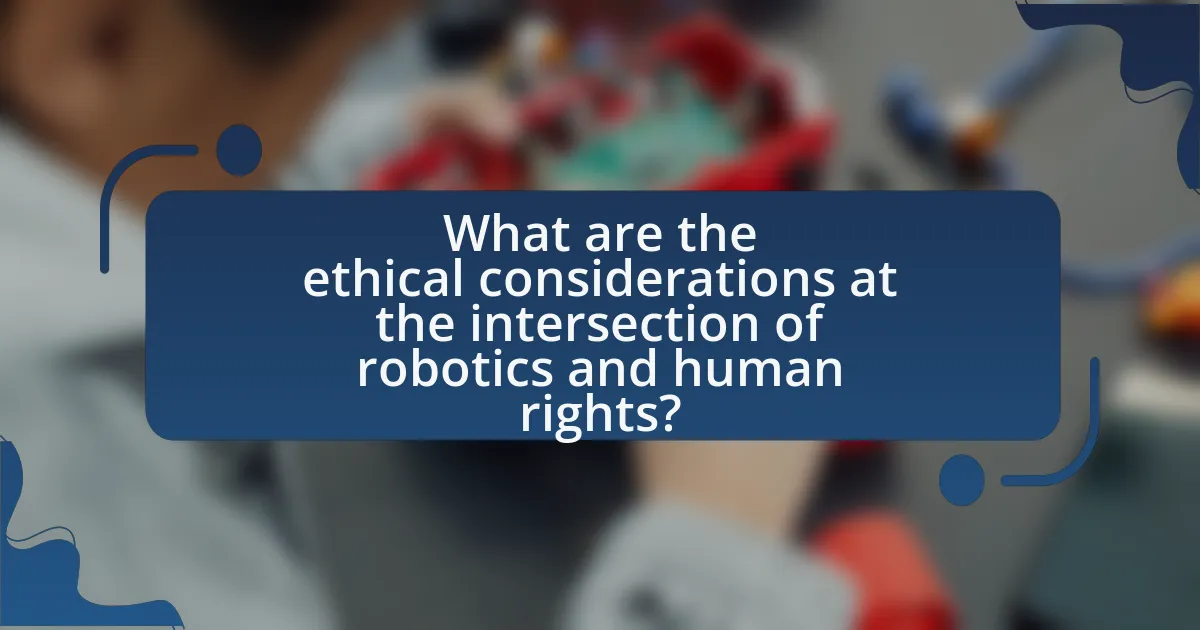
What are the ethical considerations at the intersection of robotics and human rights?
The ethical considerations at the intersection of robotics and human rights include the potential for surveillance, autonomy, and the impact on employment. Robotics can enable invasive surveillance practices that infringe on privacy rights, as seen in various countries deploying drones and facial recognition technology. Additionally, the use of autonomous robots in warfare raises questions about accountability and the right to life, as decisions made by machines can lead to unintended harm. Furthermore, the integration of robotics in the workforce poses risks to job security, potentially violating the right to work and fair labor conditions. These considerations highlight the need for ethical frameworks that prioritize human rights in the development and deployment of robotic technologies.
How do ethical frameworks guide the development of robotics?
Ethical frameworks guide the development of robotics by establishing principles that prioritize human safety, rights, and societal well-being. These frameworks, such as the IEEE Global Initiative on Ethics of Autonomous and Intelligent Systems, provide guidelines that ensure robots are designed and deployed in ways that respect human dignity and promote fairness. For instance, ethical considerations influence the programming of autonomous vehicles to prioritize human life in accident scenarios, reflecting a commitment to minimizing harm. Furthermore, adherence to ethical standards can enhance public trust in robotic technologies, as seen in studies indicating that transparency and accountability in AI systems lead to greater acceptance among users.
What ethical dilemmas arise from the use of robotics in society?
The use of robotics in society presents several ethical dilemmas, including issues of job displacement, privacy concerns, and accountability in decision-making. Job displacement occurs as automation replaces human labor, leading to economic inequality and social unrest. Privacy concerns arise from the use of surveillance robots, which can infringe on individual rights and freedoms. Accountability becomes problematic when robots make decisions that result in harm, raising questions about liability and moral responsibility. These dilemmas highlight the need for ethical frameworks to guide the integration of robotics into society, ensuring that human rights are respected and protected.
How can ethical guidelines be implemented in robotics?
Ethical guidelines can be implemented in robotics through the establishment of clear frameworks that prioritize human rights and safety. These frameworks should include principles such as transparency, accountability, and fairness, ensuring that robotic systems are designed and operated in ways that respect human dignity. For instance, the IEEE Global Initiative on Ethics of Autonomous and Intelligent Systems provides a comprehensive set of guidelines that emphasize ethical considerations in the development of robotics. By adhering to such established standards, developers can ensure that their technologies align with societal values and legal norms, thereby fostering trust and acceptance among users.
What role do policymakers play in regulating robotics and human rights?
Policymakers play a crucial role in regulating robotics and human rights by establishing legal frameworks that ensure ethical standards and protect individual rights in the development and deployment of robotic technologies. They create regulations that address issues such as privacy, accountability, and discrimination, which are essential as robotics increasingly impacts various sectors, including healthcare, law enforcement, and employment. For instance, the European Union’s General Data Protection Regulation (GDPR) includes provisions that affect how robotic systems handle personal data, thereby safeguarding human rights in the digital age. Additionally, policymakers engage with stakeholders, including technologists, ethicists, and civil society, to formulate guidelines that promote responsible innovation while mitigating risks associated with robotics.
What policies are currently in place regarding robotics and human rights?
Currently, there are no comprehensive global policies specifically addressing the intersection of robotics and human rights. However, various countries and organizations are developing frameworks and guidelines to ensure ethical considerations in robotics. For instance, the European Union has proposed regulations focusing on AI and robotics that emphasize human rights, safety, and accountability, as seen in the EU’s AI Act draft. Additionally, the United Nations has initiated discussions on the ethical implications of robotics, particularly in military applications, highlighting the need for adherence to international human rights standards. These efforts reflect a growing recognition of the importance of integrating human rights into the development and deployment of robotic technologies.
How can policymakers ensure that robotics respect human rights?
Policymakers can ensure that robotics respect human rights by establishing comprehensive regulatory frameworks that prioritize ethical standards and human dignity. These frameworks should include guidelines for the design, deployment, and operation of robotic systems, ensuring they are aligned with international human rights norms, such as the Universal Declaration of Human Rights. For instance, the European Union’s General Data Protection Regulation (GDPR) sets a precedent by emphasizing data protection and privacy, which can be adapted to robotics to safeguard individual rights. Additionally, policymakers should engage stakeholders, including ethicists, technologists, and civil society, to create inclusive policies that reflect diverse perspectives and address potential biases in robotic systems. This collaborative approach can help mitigate risks associated with automation, such as discrimination or loss of autonomy, thereby reinforcing the commitment to uphold human rights in the age of robotics.
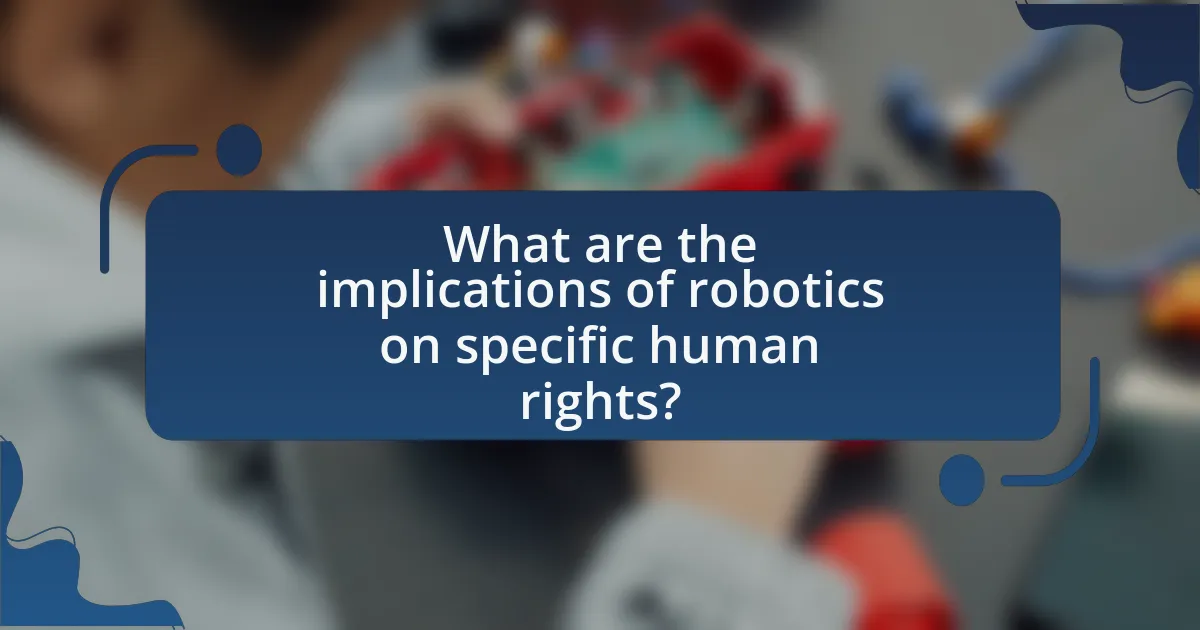
What are the implications of robotics on specific human rights?
Robotics has significant implications for specific human rights, particularly in areas such as privacy, employment, and security. The integration of robotics into daily life raises concerns about surveillance and data collection, potentially infringing on the right to privacy as seen in instances where drones and automated systems monitor individuals without consent. Additionally, the automation of jobs through robotics threatens the right to work, as many positions may become obsolete, leading to economic displacement and increased inequality. Furthermore, the use of robotic systems in law enforcement and military applications raises ethical questions regarding the right to life and due process, particularly when autonomous systems make life-and-death decisions without human oversight. These implications highlight the need for regulatory frameworks to protect human rights in the context of advancing robotic technologies.
How does robotics affect the right to privacy?
Robotics significantly impacts the right to privacy by enabling the collection and analysis of personal data through surveillance and monitoring technologies. These robotic systems, such as drones and automated cameras, can gather vast amounts of information without individuals’ consent, leading to potential violations of privacy rights. For instance, a study by the Electronic Frontier Foundation highlights that facial recognition technology used in robotics can identify individuals in public spaces, raising concerns about constant surveillance and the erosion of anonymity. Furthermore, the integration of robotics in everyday life, such as smart home devices, often involves data sharing that can compromise personal privacy if not properly secured.
What technologies in robotics pose threats to privacy rights?
Surveillance drones and autonomous robots equipped with cameras and sensors pose significant threats to privacy rights. These technologies can collect vast amounts of data on individuals without their consent, leading to potential misuse of personal information. For instance, the use of facial recognition technology in conjunction with surveillance drones has raised concerns about mass surveillance and the erosion of anonymity in public spaces. Reports indicate that cities deploying such technologies have faced backlash from civil rights organizations, highlighting the risks of unauthorized data collection and the potential for abuse by authorities.
How can privacy rights be safeguarded in the age of robotics?
Privacy rights can be safeguarded in the age of robotics through robust legal frameworks, technological safeguards, and ethical guidelines. Implementing comprehensive data protection laws, such as the General Data Protection Regulation (GDPR) in Europe, establishes clear rules on data collection, consent, and user rights, ensuring individuals maintain control over their personal information. Additionally, incorporating privacy-by-design principles in robotic systems can minimize data collection and enhance user anonymity. For instance, using encryption and anonymization techniques can protect sensitive data from unauthorized access. Furthermore, ethical guidelines developed by organizations like the IEEE emphasize the importance of transparency and accountability in robotic systems, fostering trust and protecting privacy rights.
What impact does robotics have on labor rights?
Robotics significantly impacts labor rights by automating jobs, which can lead to job displacement and reduced bargaining power for workers. As automation increases, many low-skill jobs are at risk, with a report from the McKinsey Global Institute estimating that up to 800 million global workers could be displaced by automation by 2030. This displacement can weaken labor rights as workers face increased competition for fewer jobs, leading to lower wages and diminished job security. Additionally, the rise of robotics may shift the focus of labor rights discussions towards the need for new regulations and protections for workers in automated environments, emphasizing the importance of adapting labor laws to ensure fair treatment and equitable opportunities in the evolving job market.
How does automation through robotics affect employment opportunities?
Automation through robotics significantly reduces certain employment opportunities while simultaneously creating new roles in technology and maintenance. As robots take over repetitive and manual tasks, industries such as manufacturing and logistics experience job displacement; for instance, a study by the McKinsey Global Institute estimates that up to 800 million jobs could be lost globally by 2030 due to automation. However, this shift also leads to the emergence of new jobs that require advanced skills, such as programming, robotics maintenance, and data analysis, which can offset some of the job losses. The net effect on employment opportunities varies by sector and region, highlighting the need for workforce retraining and adaptation to the changing job landscape.
What measures can be taken to protect workers’ rights in a robotic workforce?
To protect workers’ rights in a robotic workforce, implementing comprehensive labor laws that specifically address automation’s impact is essential. These laws should include provisions for job security, ensuring that workers displaced by robots receive adequate retraining and support. For instance, the European Union has proposed regulations that mandate companies to provide training programs for employees affected by automation, which can help maintain employment levels and protect workers’ rights. Additionally, establishing a framework for collective bargaining that includes workers’ representatives in discussions about automation can ensure that their voices are heard and their rights are safeguarded. Research from the International Labour Organization indicates that proactive measures in labor policy can mitigate the negative effects of automation on employment and workers’ rights.
What are the best practices for ensuring human rights in robotics?
The best practices for ensuring human rights in robotics include implementing ethical guidelines, promoting transparency, and ensuring accountability. Ethical guidelines should be established to govern the design and deployment of robotic systems, ensuring they respect human dignity and rights. Transparency in algorithms and decision-making processes allows stakeholders to understand how robots operate and make decisions, which is crucial for trust and accountability. Furthermore, accountability mechanisms must be in place to address any violations of human rights that may arise from robotic actions, ensuring that individuals or organizations can be held responsible for the consequences of robotic systems. These practices are supported by frameworks such as the European Union’s guidelines on AI, which emphasize the importance of human-centric approaches in technology development.
How can developers incorporate human rights considerations into robotics design?
Developers can incorporate human rights considerations into robotics design by integrating ethical frameworks and guidelines that prioritize human dignity, privacy, and safety. This can be achieved through conducting thorough impact assessments that evaluate how robotic systems may affect individuals and communities, ensuring compliance with international human rights standards such as the Universal Declaration of Human Rights. For instance, the IEEE Global Initiative on Ethics of Autonomous and Intelligent Systems provides a comprehensive set of principles that guide developers in creating technology that respects human rights. Additionally, involving diverse stakeholders, including human rights advocates, in the design process can help identify potential risks and promote inclusive solutions that uphold human rights.
What role does public awareness play in promoting human rights in robotics?
Public awareness plays a crucial role in promoting human rights in robotics by fostering informed discussions and advocacy around ethical standards and regulations. Increased public knowledge about the implications of robotics on human rights can lead to greater demand for accountability and transparency from developers and policymakers. For instance, awareness campaigns have highlighted issues such as privacy violations and discrimination in algorithmic decision-making, prompting legislative actions like the European Union’s General Data Protection Regulation, which aims to protect individuals’ rights in the digital age. Thus, public awareness not only educates society about potential risks but also empowers individuals to advocate for their rights in the evolving landscape of robotics.
